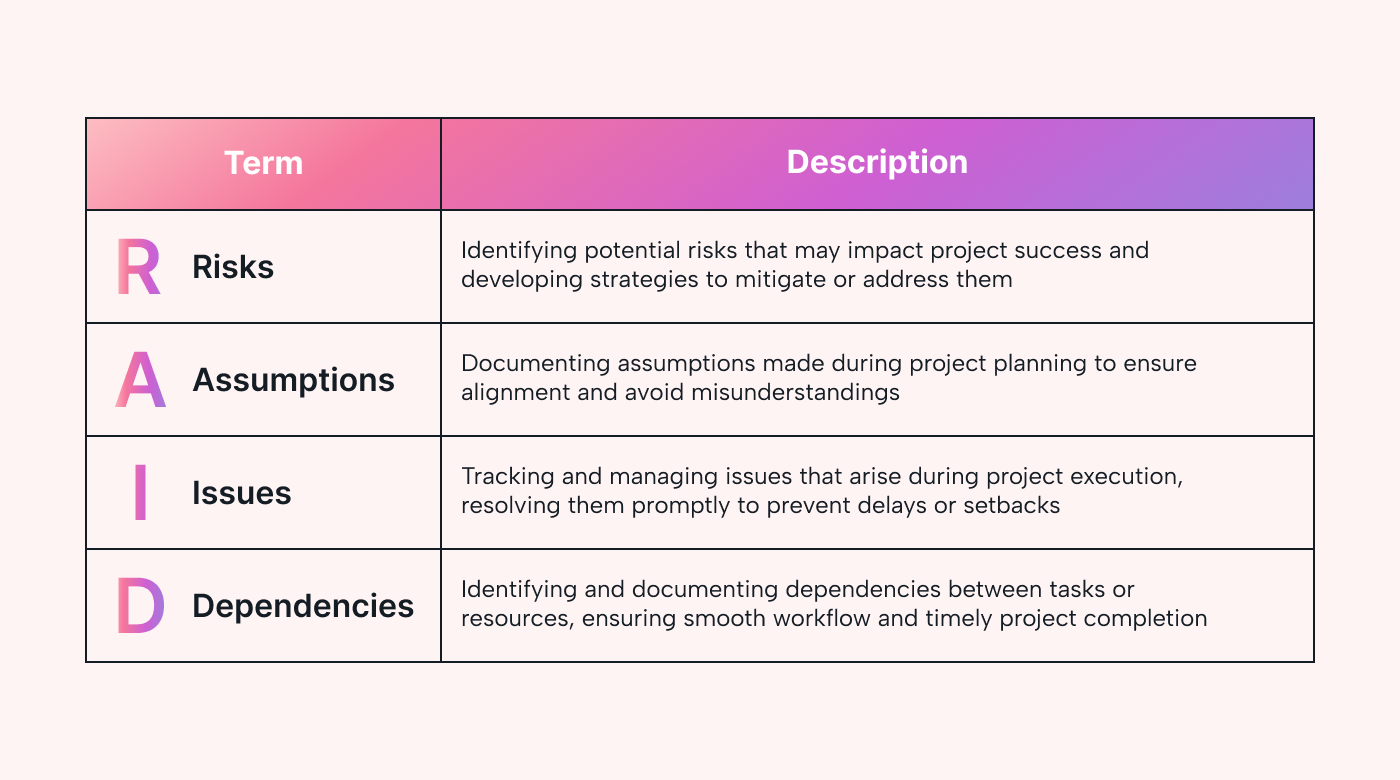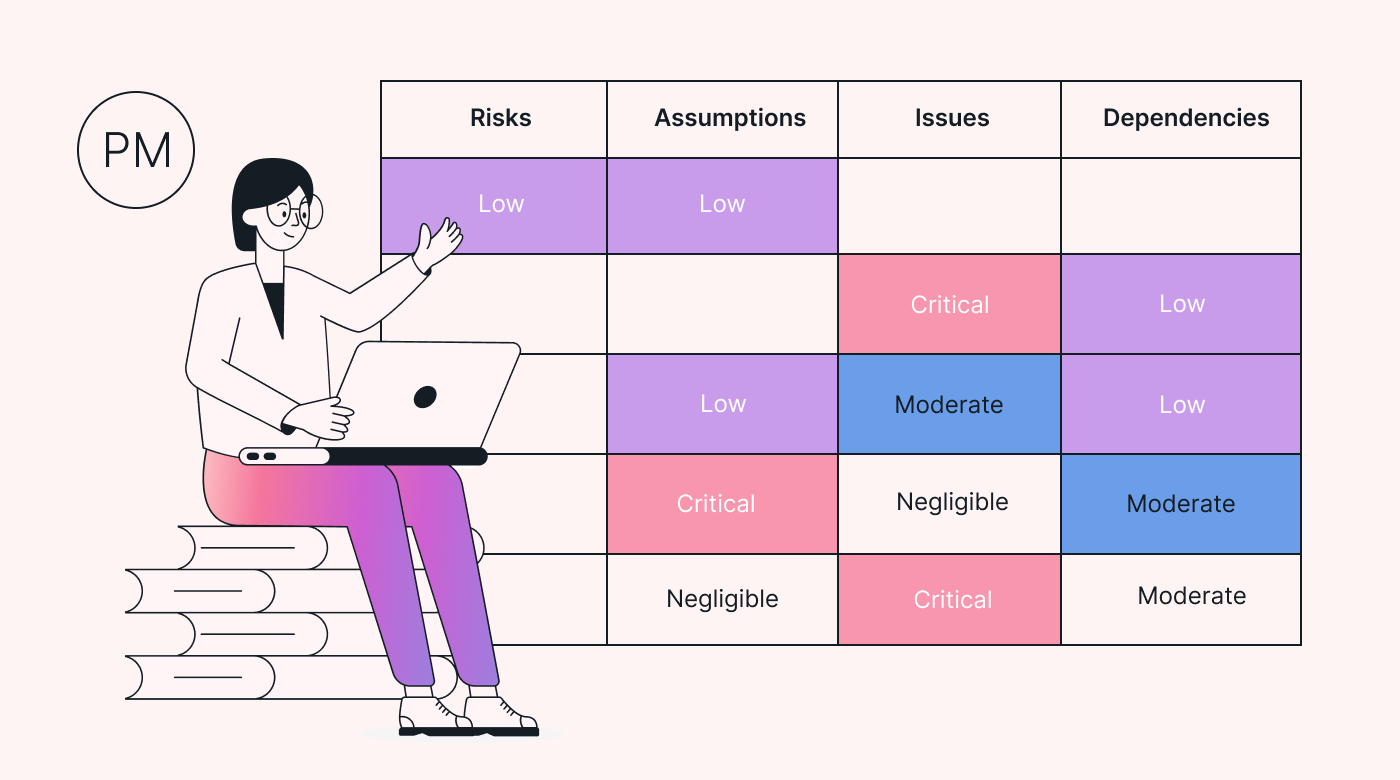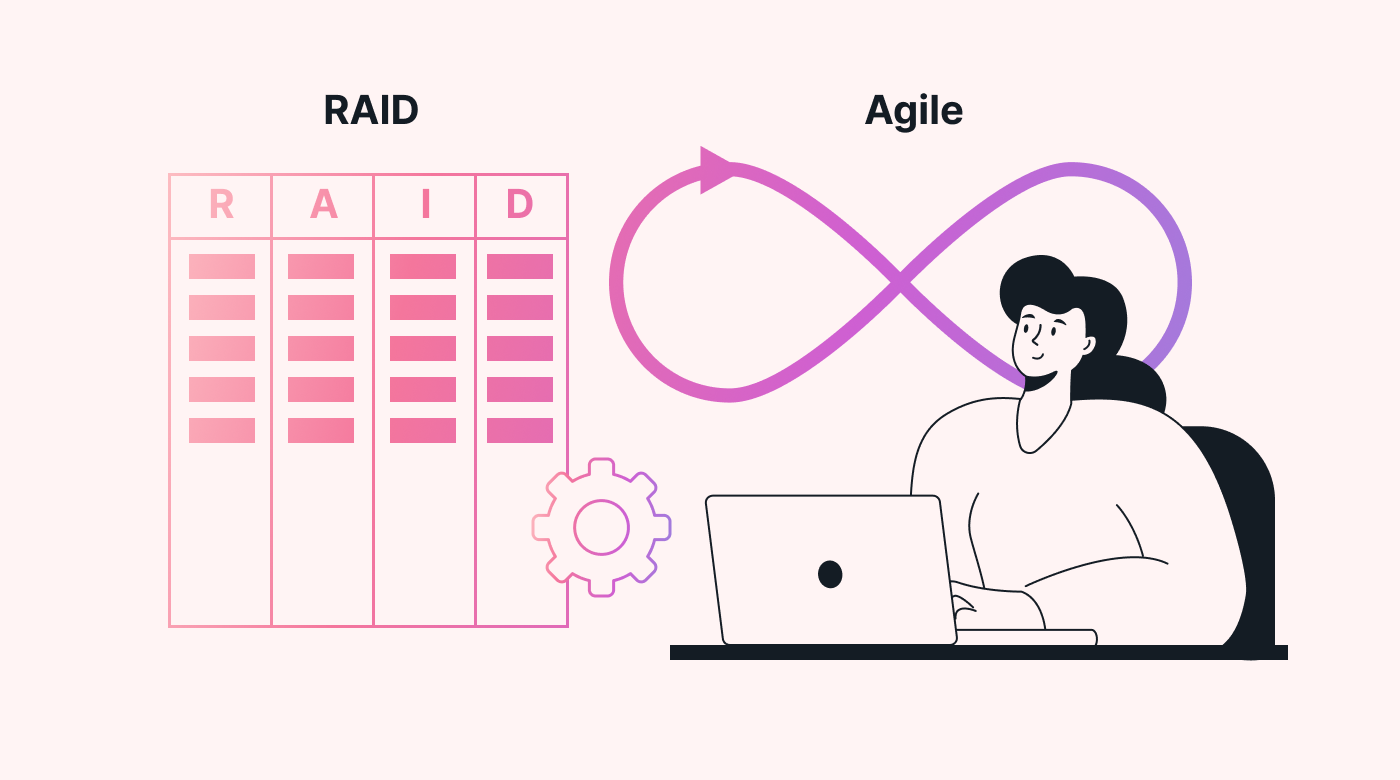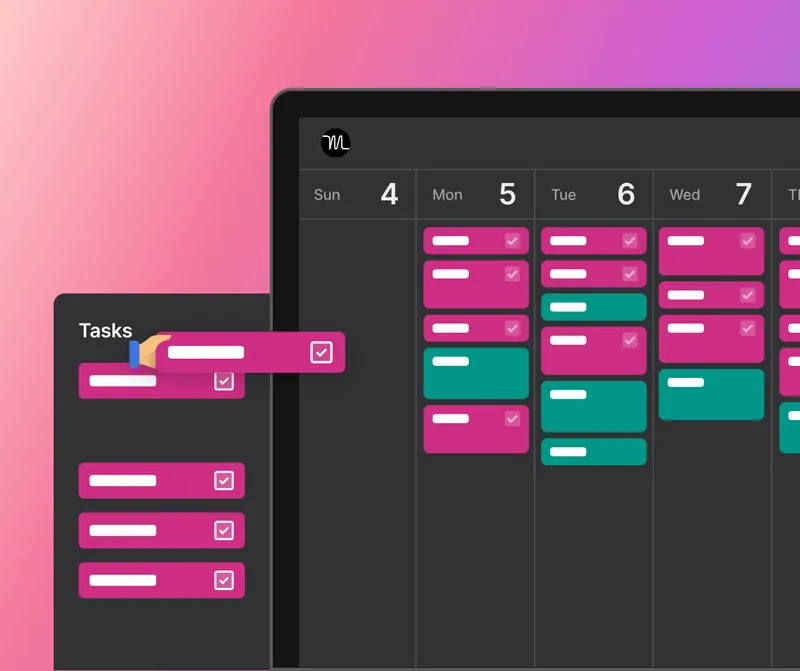Are you finding it difficult to manage deadlines? Are unforeseen issues creeping in?
Managing tasks can be a daunting endeavor. Unplanned issues can make it even worse.
From juggling multiple projects to navigating unforeseen risks and dependencies, staying on track can feel like a constant battle.
This is where RAID logs come to the rescue.
RAID logs have emerged as a game-changer in the realm of project management. They offer a comprehensive and structured approach to addressing project challenges.
Together, we’ll explore the power of RAID logs as an indispensable tool for managing projects. We’ll delve into the core components of RAID logs and uncover how they can revolutionize your approach.
Let’s dive right in.
What is a RAID log?
The RAID acronym is Risks, Assumptions, Issues, and Dependencies or Decisions. These represent the core components of a RAID log. It serves as a vital compass, guiding project managers and teams through the ever-changing tides of project execution.
Think of it as a ship's log, recording crucial information to keep your projects on course.
 |
At its essence, a RAID log is a thorough record that captures and manages a project’s risks, assumptions, issues, and dependencies.
They are pivotal in mitigating project risks and systematically documenting key elements so project teams can handle them later.
Benefits of using RAID logs
RAID logs offer many benefits that can revolutionize your approach to project management.
 |
They enable proactive risk management. You can steer clear of potential pitfalls by identifying and documenting potential risks at the outset.
RAID logs foster improved communication among team members. They serve as a shared reference point, ensuring everyone is on the same page about potential problems.
Informed decision-making is another key advantage of RAID logs. Armed with a comprehensive overview of the project’s landscape, you can make well-informed choices.
How to use a RAID log for any project
Now that we understand the significance of RAID logs let’s explore how to harness their power for any project. By following a clear and structured approach, you can navigate project with confidence.
Step 1: Identify the relevant risks, assumptions, issues, and dependencies
To harness the power of RAID logs, identify the critical factors that can impact your project’s success. Consider:
- Potential risks that could arise
- Assumptions that underpin your project's foundation
- Issues that may impede progress
- And dependencies that influence timelines and deliverables
When identifying risks, consider internal and external factors that could threaten your project. Scrutinize assumptions to confirm they’re sound and align with reality. Address potential issues that may arise during project execution. Finally, map out dependencies to understand the connection between tasks and deliverables.
To gather insights and perspectives, consult project stakeholders, subject experts, and your project team. Engage in open dialogue and cover all potential factors influencing your project’s course.
Step 2: Prioritize and assess the identified factors
Now that you have identified the problems, it’s time to prioritize and assess their impact. Prioritization within your RAID log lets you focus on what benefits your project most.
Assign importance or urgency to each identified factor based on its potential impact on the project’s success. Consider factors such as:
- Likelihood of occurrence
- Potential consequences
- Alignment with project objectives
To assess the impact and likelihood of each factor, employ various strategies. Conduct thorough research, gather data, and engage in informed discussions with your team. Also, leverage tools like probability and impact matrices to test the significance of each factor.
Step 3: Document and track changes in the RAID log
Documenting the identified factors serves as a reliable reference point. It captures the initial assessment, providing a baseline for comparison as you progress. Think of it as a historical warehouse of valuable insights.
Here are some recommendations for maintaining an up-to-date and accurate RAID log:
- Schedule periodic reviews to assess the status of each factor and make necessary updates. This keeps your RAID log current and reflective of the project's reality.
- Engage stakeholders in the review process to gather diverse perspectives and validate accuracy.
- Implement a system to track changes to the RAID log, such as version control or a change log. This allows you to trace the evolution of factors and understand the reasons behind modifications.
Step 4: Use the RAID log to inform decision-making
It's time to leverage all this valuable information to make informed decisions that drive project success.
Let's explore how the information captured can inform decision-making:
- The RAID log helps to prioritize resource allocation based on the severity and likelihood of risks. For example, you can allocate additional resources or adjust timelines for a high-impact risk.
- With the clarity of RAID logs, you can develop strategies to mitigate problems. For instance, if an assumption is incorrect, you can make informed decisions to revise project plans.
- Your RAID log also helps you address and resolve project issues. By tracking the problems identified, you gain visibility into their status, priority, and impact on milestones.
Consider a scenario where you are managing an event. Your RAID log highlights a dependency on securing a specific venue. Knowing this, you can make data-driven decisions to negotiate contracts. You can reschedule event dates or explore backup options.
Step 5: Review and update the RAID log
The last step is maintaining your RAID log’s accuracy and relevance through regular reviews and updates.
To ensure the RAID log remains a valuable and reliable resource, consider implementing the following recommendations:
- Set a regular schedule for reviewing the RAID log.
- Make the RAID log review a collaborative effort involving all key participating members. This provides different views and insights.
- As you review the RAID log, identify any changes in the status of risks, assumptions, issues, and dependencies. If a risk materializes or a hypothesis is proven incorrect, update the log.
Regarding the last point, remember this: If a risk identified in the log comes to fruition, it’s “switched” to an issue. This dynamic nature of the RAID log allows it to adapt to the evolving project landscape.
Practical uses for RAID logs & examples
RAID logs aren't just theoretical tools. They have tangible applications across industries and can address real-world management challenges.
One of these areas is in traditional businesses. In these environments, managing risks and processes can be overwhelming. With RAID logs, you put a comprehensive yet adaptable process behind managing risks and workflows.
For example, a manufacturing company can use a RAID log to identify potential supply chain disruptions. Or to assess their impact and develop contingency plans to ensure timely production.
Integrating Motion with RAID logs streamlines workflows and risk mitigation even more. With Motion, teams can track changes, and receive notifications for risk triggers, no matter the industry.
RAID analysis vs. RAID logs
While RAID analysis and RAID logs share a similar acronym, they serve distinct purposes and offer unique perspectives on project management. Here’s how they differ:
RAID analysis qualitatively evaluates and assesses risks, assumptions, issues, and dependencies. On the other hand, RAID logs are a dynamic documentation tool, capturing the identified factors and their associated details.
To make the most of these approaches, consider using RAID analysis as an initial assessment and prioritization framework. Once the factors are identified, document them in a RAID log to track their evolution and monitor their impact over time.
Implementing RAID logs in Agile project management
Using RAID logs in Agile requires minimal adaptations due to their inherent flexibility.
While Agile methodologies prioritize adaptive development, they still carry risks. Therefore, they can benefit from the proactive approach of the RAID log.
 |
To effectively use RAID logs in an Agile context, consider the following best practices:
- Regularly reviewing and updating the RAID log during Agile ceremonies
- Assess and reassess risks, assumptions, issues, and dependencies as Agile projects evolve
- Make the RAID log accessible to all team members
How Motion can help manage RAID logs
Motion, the AI calendar app, can enhance the management of RAID logs in your business.
With its intuitive features and seamless integration with project management processes, Motion offers several advantages:
- Motion automatically plans your day, considering deadlines, working hours, and task links. This allows you to allocate time for managing RAID logs.
- Motion helps prioritize tasks based on their importance, deadlines, and available time slots. By incorporating RAID log activities into your task list, you can ensure they receive appropriate attention.
- Motion provides clear visibility into your schedule, including RAID log-related activities. It sends reminders and alerts to keep you on track with RAID log updates and reviews.
- Motion facilitates collaboration by allowing you to share and coordinate RAID log activities with your team members.
Use RAID logs and Motion as your secret weapons
RAID logs are a project management tool used to help identify, track, and mitigate risks, assumptions, issues, and dependencies. By maintaining a comprehensive RAID log, businesses can:
- Improve risk management
- Enhance communication
- Practice informed decision-making
However, having a RAID log might not be enough. Leveraging advanced tools like Motion is essential for optimal project management. Motion takes RAID logs to the next level, providing a centralized platform that streamlines the management of risks and dependencies. It facilitates collaboration and offers real-time insights into project health.
Don’t miss out on the opportunity to supercharge your project management efforts.
Start your 7-day free trial of Motion.






